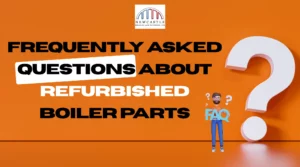What Does Baxi boiler E code Means?
If your Baxi boiler displays a code that starts with the letter ‘E’, it means the system has detected a fault. The ‘E’ stands for ‘Error’, and the numbers that follow help identify the specific issue your boiler is facing.
These error codes are part of the boiler’s self-diagnostic system. They make it easier to pinpoint faults such as ignition problems, low pressure, overheating, or sensor failures. Understanding what each code means can help you troubleshoot faster and decide whether you can fix the issue yourself—or if it’s time to call a professional.

Common Baxi boiler E code
Here are some of the most frequent ‘E’ error codes on Baxi boilers and what they mean:
1. Baxi E119 – Low Water Pressure
- Your boiler pressure has dropped below the required level.
- Check the pressure gauge; if it’s below 1 bar, you may need to repressurise the system.
- Use the filling loop to add water until the pressure reaches 1.0-1.5 bar.
- Know more about Baxi E119 fault code
2. Baxi E133 – Ignition Failure or Gas Supply Issue
- The boiler failed to ignite due to gas supply problems.
- Ensure the gas supply is on and check other gas appliances.
- Try resetting the boiler; if the issue persists, contact a Gas Safe engineer.
- Know more about Baxi E113 fault code
3. E168 – Boiler Lockout Due to Power or System Fault
- A system or electrical fault has caused the boiler to shut down.
- Check if there was a power outage or if the fuse has tripped.
- Reset the boiler and monitor if the issue repeats.
- Know more about Baxi E168 fault code
4. Baxi E125 – Circulation Fault
- The boiler detects a blockage or an issue with water flow.
- Airlocks, a faulty pump, or a clogged filter may cause this error.
- Bleed the radiators and check for trapped air in the system.
- Know more about Baxi E125 fault code
5. Baxi E160 – Fan Fault
- The fan isn’t operating correctly, preventing safe ventilation.
- A faulty fan or wiring issue may trigger this error.
- Contact a qualified engineer to inspect and repair the fan.
- Know more about Baxi E160 fault code
How to Reset Boiler After Baxi boiler E code?
If your boiler locks out after displaying an ‘E’ code, resetting it may help:
- Locate the reset button (usually on the front panel).
- Press and hold it for 5–10 seconds.
- Wait for the boiler to restart and check if the error clears.
If the fault code returns, it may indicate a deeper issue that needs professional attention.
When to Call a Professional
Some minor faults, like low pressure or airlocks, can be fixed on your own. However, if the boiler continues displaying error codes, you should call a Gas Safe registered engineer. Ignoring repeated errors can lead to bigger issues and potential safety risks.
Conclusion on ‘E’ (Error)
Baxi boilers use ‘E’ codes to signal faults that need fixing. While some issues, like low pressure, are easy to resolve, others may require professional repairs. Regular maintenance and timely troubleshooting can help keep your boiler running smoothly and efficiently.
FAQ’s on Baxi ‘E‘ (Error)
The ‘E’ on a Baxi boiler stands for “error”. It’s followed by a number, such as E119 or E133, which helps identify the exact fault. These codes are built-in diagnostics that alert users to issues like overheating, low pressure, or ignition failure.
To fix an ‘E’ error, start by identifying the full code (e.g., E119 for low pressure). Common fixes include resetting the boiler, topping up system pressure, bleeding radiators, or checking for blockages. If the issue continues, call a Gas Safe registered engineer.
The ‘E’ symbol is part of the boiler’s fault code system. It alerts you that a fault has been detected and the boiler may not operate until it’s resolved. It’s not a permanent issue, but it does require action.
You can often clear a Baxi boiler error by pressing the reset button on the control panel. However, if the underlying issue isn’t fixed, the error may reappear. Always identify and resolve the root problem before resetting.
Yes, Baxi combi boilers are considered reliable and energy-efficient. They are popular in UK homes for their compact design, ease of use, and solid warranties. Many models also offer smart features and quiet operation. Always choose a model that fits your home’s heating needs and get it installed by a qualified engineer.




